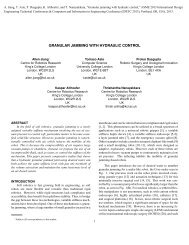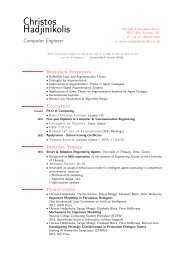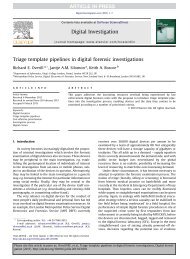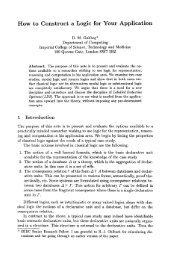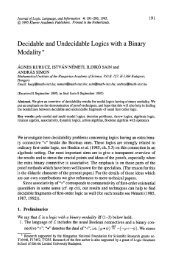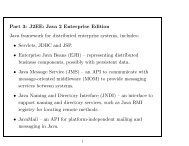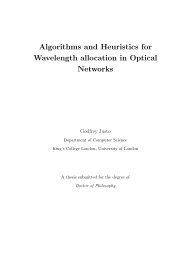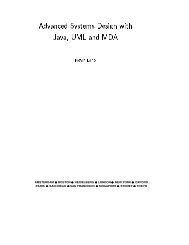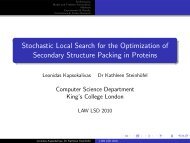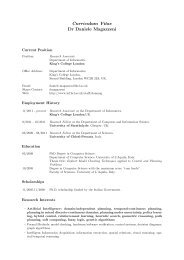⎧Undefined if (i, j) /∈ M,⎪⎨1 if (i = 1 or j = 1) <strong>and</strong> (i, j) ∈ MT [i, j] =1 + max 1≤li j) wemust have T [i ′ ][j] ≥ T [i][j] (resp. T [i][j ′ ] ≥ T [i][j]).Fact 2. ([24]) The calculation of a T [i][j], (i, j) ∈ M, 1 ≤ i, j ≤ n is independent ofany T [l][q], (l, q) ∈ M, l = i, 1 ≤ q ≤ n.Along with the above two facts, we use the ‘BoundedHeap’ data structure of [7] thatsupports the following operations:Insert(H, pos, val, data): Insert into the BoundedHeap H the position pos with valueval <strong>and</strong> associated in<strong>for</strong>mation data.IncreaseV alue(H, pos, val, data): If H does not already contain the position pos,per<strong>for</strong>m Insert(H, pos, val, data). Otherwise, set this position’s value to max{val, val ′ },where val ′ is its previous value. Also, change the ‘data’ field accordingly.BoundedMax(H, pos): Return the item (with additional data) that has maximumvalue among all items in H with position smaller than pos. If H does not containany items with position smaller than pos, return 0.The following theorem from [7] presents the time complexity of the BoundedHeapdata structure.Theorem 1. ([7]) BoundedHeap data structure can support each of the above operationsin O(log log n) amortized time, where keys are drawn from the set {1, . . . , n}.The data structure requires O(n) space.The algorithm Alg<strong>LCS</strong><strong>New</strong> proceeds as follows. Recall that we per<strong>for</strong>m a rowby row operation. We always deal with two BoundedHeap data structures. Whileconsidering row i, we already have the BoundedHeap data structure H i−1 at ourh<strong>and</strong>; now we construct the BoundedHeap data structure H i . At first H i is initialized2 In [24], the running time of this preprocessing step is reported as O(R log log n) under the usual assumptionthat R ≥ n.
to H i−1 . Assume that we are considering the match (i, j) ∈ M i , 1 ≤ j ≤ n, whereM i = {(i, j) | (i, j) ∈ M, 1 ≤ j ≤ n}. We calculate T [i, j] as follows:T [i, j].Value = BoundedMax(H i−1 , j).Value + 1.T [i, j].Prev = BoundedMax(H i−1 , j).data 3 .Then we per<strong>for</strong>m the following operation:IncreaseV alue(H i , j, T [i, j].Value, (i, j)).The correctness of the above procedure follows from Fact 1 <strong>and</strong> 2. Due to Fact 1,as soon as we compute the T -value of a new match in a column j, we can <strong>for</strong>get aboutthe previous matches of that column. So, as soon as we compute T [i, j] in row i, weinsert it in H i to update it <strong>for</strong> the next row i.e. i + 1. And due to Fact 2, we can useH i−1 <strong>for</strong> the computation of the T -values of the matches in row i <strong>and</strong> do the updatein H i (initialized at first to H i−1 ) to make H i ready <strong>for</strong> row i + 1.Next, we analyze the running time of Alg<strong>LCS</strong><strong>New</strong>. The preprocessing requiresO(R log log n + n) time to get the set M in the required order [24]. Then we calculateeach (i, j) ∈ M according to Equation 1 using the BoundedHeap data structure.Note carefully that we need to use the two operations, BoundedMax() <strong>and</strong>IncreaseV alue(), once each <strong>for</strong> each of the matches in M. So, in total the runningtime is O(R log log n + n). The space requirement is as follows. The preprocessingstep requires θ(max{R, n}) space [24]. And, in the main algorithm, we only needto keep track of two BoundedHeap data structures at a time, requiring O(n) space(Theorem 1). So, in total the space requirement is θ(max{R, n}).Theorem 2. <strong>Problem</strong> <strong>LCS</strong> can be solved in O(R log log n+n) time requiring θ(max{R, n})space.Algorithm 1 <strong>for</strong>mally presents the algorithm. Since we are not calculating all theentries of the table, we, off course, need to use variables to keep track of the actual<strong>LCS</strong>.4 C<strong>LCS</strong> AlgorithmIn this section, we present the new algorithm <strong>for</strong> <strong>Problem</strong> C<strong>LCS</strong>. We use the dynamicprogramming <strong>for</strong>mulation <strong>for</strong> C<strong>LCS</strong> presented in [2, 3]. Extending our tabularnotion from Equation 1, we use T [i, j, k], 1 ≤ i, j ≤ n, 0 ≤ k ≤ p to denoteL Z[1..k] (X[1..i], Y [1..j]). We have the following <strong>for</strong>mulation <strong>for</strong> <strong>Problem</strong> C<strong>LCS</strong> from [2,3].T [i, j, k] = max{T ′ [i, j, k], T ′′ [i, j, k], T [i, j − 1, k], T [i − 1, j, k]} (2)3 Note that, we use the ‘data’ field to keep the ‘address’ of the match.



